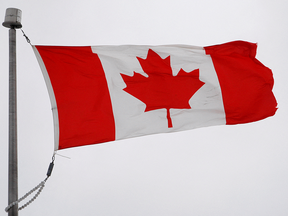Canada’s economy continues to defy expectations for a pullback.
Business
What economists are saying about the latest GDP numbers

Statistics Canada released data on March 31 that showed the economy grew 0.5 per cent month over month in January, a remarkable reversal from December when GDP contracted 0.1 per cent. January’s reading also beat Bay Street analysts estimate for growth of 0.4 per cent.
While the report showed an economy healthier than many expected, economists now think the GDP surprise could make the Bank of Canada‘s job tougher as it seeks to cool inflation by raising interest rates to tamp down demand.
Here’s what some of them are saying about the GDP numbers and what it means for the Bank of Canada and interest rates.
Charles St-Arnaud, Alberta Central
“Today’s release of the monthly GDP suggests that the Canadian economy started the year strong. As such, the strength in January and February is pointing to growth in the first quarter of 2023 at around three per cent quarter over quarter annual rate, far from a contraction. This follows a period of weakness in the last quarter of 2022, as higher interest rates took a toll on rate-sensitive sectors.
“The Bank of Canada is likely at a crucial juncture and facing a significant dilemma. The central bank may have to choose between fighting inflation and hiking interest rates again or focusing on financial stability and keeping rates on hold.”
Stephen Brown, Capital Economics
“The strength of GDP growth in January, and probably February too, suggests the Bank of Canada will use its April meeting to reiterate that, despite the recent banking turmoil, it is still prepared to raise interest rates again if needed.
“The big surprise is that, despite the early estimates showing falls in manufacturing, wholesale and retail sales in February, the preliminary estimate points to another 0.3 per cent month-over-month gain in GDP last month. That gain implies the economy is heading for growth of about 2.5 per cent annualized this quarter, slightly higher than the two per cent gain we have pencilled in.
“A 2.5 per cent expansion would also be stronger than the bank’s forecast of a 0.5 per cent rise, but recall that the stagnation in GDP last quarter was weaker than the bank’s estimate of a 1.3 per cent gain. Moreover, we know that the rebound in activity is helping to lower prices rather than contributing to inflationary pressures. For example, the CPI passenger vehicle price index fell by 2.5 per cent over the first two months of the year. So while the bank will stick to its hawkish messaging, we doubt recent developments will cause it resume rate hikes.”
Douglas Porter, BMO Economics
“There were many indications that the economy got off to a solid start in 2023, but today’s double-barrelled blast of strength is well above even the most optimistic views. Even if growth stalls in March, it now looks like Q1 will post growth of 2.5 per cent, up from a flat read in Q4. While we continue to look for a notable cool-down in the next two quarters, we are bumping up our GDP growth estimate for all of 2023 by three ticks to one per cent. Suffice it to say that if the strength seen in the opening months of the year persists, the Bank of Canada is going to find itself in a tough spot.”
Randall Barlett, Desjardins Economics
“Today’s outsized move in January real GDP and continued momentum through February leaves little room to equivocate. The Canadian economy started the year on a very strong footing. We are now tracking real GDP growth approaching three per cent annualized in Q1, well above the bank’s 0.5 per cent tracking in the January 2023 monetary policy report.
Tony Stillo, Oxford Economics
Matthieu Arseneau and Alexandra Ducharme, National Bank of Canada Economics
“Despite the continued rebound of the Canadian economy in Q1 after a sluggish quarter, we still believe that the Bank of Canada should maintain its pause in monetary tightening. The rate hikes have been very aggressive and will continue to weigh on the economy given the lag in their pass-through.
“In addition, the outcome of the ongoing turmoil in the global banking sector and its impact on credit conditions in the coming months remains uncertain. We expect to see ups and downs in output in later quarters that will leave GDP essentially flat over the next year. This is an argument for patience. All the more so given the encouraging developments in inflation that are now emerging.”
Jay Zhao-Murray, currency market analyst, Monex Canada
“While the Bank of Canada is currently on a conditional pause as it awaits more data, the strength in the real economy, as measured by upward revisions from last month’s preliminary figure (for GDP) and another probable above-potential reading in February, could tilt the central bank in a more hawkish direction.
“While it is still too early to call for another rate hike, the odds are shifting in that direction: BoC officials stated they are mostly worried about upside risks to inflation and have shown little panic about recent global banking troubles. Stronger growth means the costs to another hike are falling, and it also puts upward pressure on inflation. Markets largely agree with our assessment, as they are now pricing only 35 basis points of rate cuts by year end, the fewest in nearly three weeks, and a far cry from the 90 basis points of cuts priced just a week ago.”
• Email: gmvsuhanic@postmedia.com | Twitter:

Business
Cineplex reports $24.7M Q3 loss on Competition Tribunal penalty

TORONTO – Cineplex Inc. reported a loss in its latest quarter compared with a profit a year ago as it was hit by a fine for deceptive marketing practices imposed by the Competition Tribunal.
The movie theatre company says it lost $24.7 million or 39 cents per diluted share for the quarter ended Sept. 30 compared with a profit of $29.7 million or 40 cents per diluted share a year earlier.
The results in the most recent quarter included a $39.2-million provision related to the Competition Tribunal decision, which Cineplex is appealing.
The Competition Bureau accused the company of misleading theatregoers by not immediately presenting them with the full price of a movie ticket when they purchased seats online, a view the company has rejected.
Revenue for the quarter totalled $395.6 million, down from $414.5 million in the same quarter last year, while theatre attendance totalled 13.3 million for the quarter compared with nearly 15.7 million a year earlier.
Box office revenue per patron in the quarter climbed to $13.19 compared with $12 in the same quarter last year, while concession revenue per patron amounted to $9.85, up from $8.44 a year ago.
This report by The Canadian Press was first published Nov. 6, 2024.
Companies in this story: (TSX:CGX)
The Canadian Press. All rights reserved.
Business
Restaurant Brands reports US$357M Q3 net income, down from US$364M a year ago

TORONTO – Restaurant Brands International Inc. reported net income of US$357 million for its third quarter, down from US$364 million in the same quarter last year.
The company, which keeps its books in U.S. dollars, says its profit amounted to 79 cents US per diluted share for the quarter ended Sept. 30 compared with 79 cents US per diluted share a year earlier.
Revenue for the parent company of Tim Hortons, Burger King, Popeyes and Firehouse Subs, totalled US$2.29 billion, up from US$1.84 billion in the same quarter last year.
Consolidated comparable sales were up 0.3 per cent.
On an adjusted basis, Restaurant Brands says it earned 93 cents US per diluted share in its latest quarter, up from an adjusted profit of 90 cents US per diluted share a year earlier.
The average analyst estimate had been for a profit of 95 cents US per share, according to LSEG Data & Analytics.
This report by The Canadian Press was first published Nov. 5, 2024.
Companies in this story: (TSX:QSR)
The Canadian Press. All rights reserved.
Business
Electric and gas utility Fortis reports $420M Q3 profit, up from $394M a year ago

ST. JOHN’S, N.L. – Fortis Inc. reported a third-quarter profit of $420 million, up from $394 million in the same quarter last year.
The electric and gas utility says the profit amounted to 85 cents per share for the quarter ended Sept. 30, up from 81 cents per share a year earlier.
Fortis says the increase was driven by rate base growth across its utilities, and strong earnings in Arizona largely reflecting new customer rates at Tucson Electric Power.
Revenue in the quarter totalled $2.77 billion, up from $2.72 billion in the same quarter last year.
On an adjusted basis, Fortis says it earned 85 cents per share in its latest quarter, up from an adjusted profit of 84 cents per share in the third quarter of 2023.
The average analyst estimate had been for a profit of 82 cents per share, according to LSEG Data & Analytics.
This report by The Canadian Press was first published Nov. 5, 2024.
Companies in this story: (TSX:FTS)
The Canadian Press. All rights reserved.
-

 News12 hours ago
News12 hours agoAlberta aims to add two seats to legislature, bringing total to 89 for next election
-

 News20 hours ago
News20 hours agoTrump snaps at reporter when asked about abortion: ‘Stop talking about it’
-

 News12 hours ago
News12 hours agoPembina Pipeline earnings rise year over year to $385 million in third quarter
-

 News20 hours ago
News20 hours agoUN refugee chief: Canada cutbacks can avoid anti-immigrant backlash
-

 News20 hours ago
News20 hours agoParty leaders pay tribute following death of retired senator Murray Sinclair
-

 News20 hours ago
News20 hours agoCanadians remember Quincy Jones
-

 News12 hours ago
News12 hours ago‘He violated me’: Women tell sex assault trial Regina chiropractor pulled breasts
-

 News20 hours ago
News20 hours agoBeyoncé channels Pamela Anderson in ‘Baywatch’ for Halloween video asking viewers to vote





















